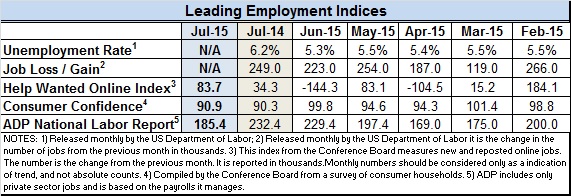 Employers added 215,000 jobs in July, a gain not far off from economists were predicting. The unemployment rate was unchanged last month at 5.3 percent.
Employers added 215,000 jobs in July, a gain not far off from economists were predicting. The unemployment rate was unchanged last month at 5.3 percent.
This morning’s report from the U.S. Department of Labor also raised the initial counts for May and June, adding a combined 14,000 jobs. Employes have added an average of 211,000 new jobs each month. The average last year for the same 7 months was 252,000.
This report is being more closely watched by Wall Street as it awaits the decision by the Federal Reserve on raising interest rates. Gus Faucher, senior economist at PNC Financial Services, told The New York Times the July and August employment reports were especially important as they could affect the timing of the Fed’s rate change.
“It could be September or it could be December,” he said. “These two job reports will make the difference.”
Beyond just the number of jobs, economists are also watching the monthly change in pay rates and the size of the labor force.
On both those fronts, the July Labor Department report said there was little change. Average hourly pay for all private, non-farm employees rose 5 cents to $24.99, an annual rate of 2.1 percent, a pace that hasn’t increased in several years. The labor force participation rate was unchanged at 62.6 percent, the lowest rate in four decades.
Healthcare again showed some of the strongest job growth, adding 27,900 jobs. Hospitals accounted for 15,700 of the new jobs. Other gainers:
- Bars and restaurants added 29,300 jobs, while hotels, motels and other accommodations grew by 4,300 jobs, boosting the gains in the leisure and hospitality sector to 30,000 jobs.
- Auto, truck and parts dealers were up 12,500 jobs, as the broader retail sector grew by 35,900.
- The slow-growing financial activities sector added 17,000 jobs, almost entirely due to real estate, rental and leasing (+6,000), and insurance jobs (+9,600).
- Surprisingly strong growth in professional and technical services, which includes jobs in accounting and bookkeeping, engineering and architecture, and computer systems designs and related services. The sector added 26,600 new jobs.
- Manufacturing added 15,000 jobs, entirely due to growth in the non-durable goods category which grew by 23,000 jobs. Those gains were offset by 8,000 job cuts in durable goods, which include equipment manufacturing.
Other jobs losses included 4,900 cuts in oil and gas and temp help, which was down by 8,900.